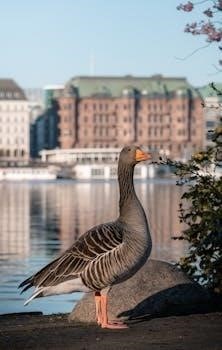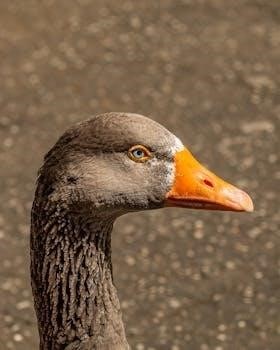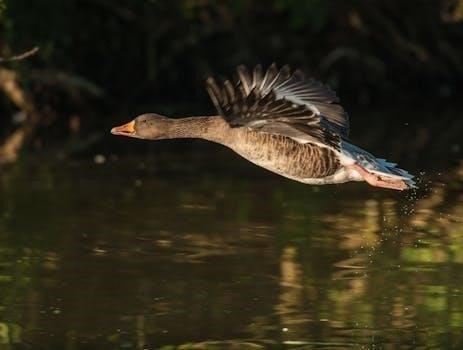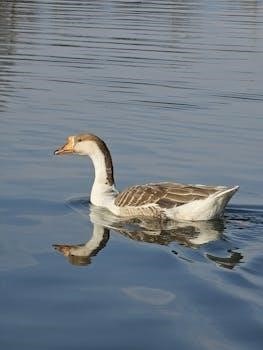Overview of “Wild Geese” by Mary Oliver
Mary Oliver’s “Wild Geese” is a celebrated poem from her collection “Dream Work,” offering a message of acceptance and belonging. It encourages readers to embrace their true nature and find solace in the world around them.

Mary Oliver’s Life and Work
Mary Oliver (1935-2019) was a Pulitzer Prize-winning American poet known for her accessible and nature-inspired verse. Her work explores themes of spirituality, the human connection to nature, and finding beauty in everyday life, resonating with a wide audience.
Oliver’s Connection to Nature
Mary Oliver’s profound connection to nature is a defining characteristic of her life and work. Spending much of her time observing the natural world, she found inspiration and solace in its beauty and complexity. Her poetry reflects a deep understanding of ecosystems, wildlife, and the cyclical rhythms of the seasons.
Oliver’s ability to translate these observations into evocative language is a testament to her keen senses and contemplative spirit. Nature, for Oliver, wasn’t just a backdrop but a teacher, a source of spiritual insight, and a mirror reflecting the human condition. She saw parallels between the struggles and triumphs of humans and the resilience and adaptability of the natural world.
Through her poetry, Oliver invites readers to cultivate a similar connection, encouraging them to slow down, observe, and appreciate the wonders that surround them.
“Wild Geese”⁚ Summary and Meaning
“Wild Geese” by Mary Oliver is a lyrical poem that offers a message of hope and self-acceptance. The speaker urges the reader to let go of the need to be “good” and instead embrace their true nature. The poem suggests that amidst life’s struggles and feelings of despair, one can find solace in the natural world.
The wild geese, high in the sky, symbolize freedom and the call to return home to oneself. The poem’s meaning lies in its invitation to connect with the world and recognize one’s place within the “family of things.” Oliver encourages readers to embrace their imperfections and find comfort in the vastness and beauty of nature, which continues on regardless of human struggles. It’s about finding your place and belonging, despite feelings of loneliness.
Analysis of Poetic Devices in “Wild Geese”
Oliver employs vivid imagery and symbolism, particularly through the wild geese, to convey themes of freedom and belonging. Repetition and alliteration also contribute to the poem’s musicality and emphasis on key ideas.
Imagery and Symbolism of Wild Geese
The “wild geese” themselves are a central symbol in Oliver’s poem, representing freedom, nature, and the call to return to one’s true self. Their flight across the “clean blue air” evokes a sense of liberation from societal constraints and personal burdens.
The imagery of the natural world – “prairies,” “deep trees,” “mountains,” and “rivers” – reinforces the interconnectedness of all things and the comforting presence of the environment. These images serve as a backdrop to the human experience, suggesting that even in despair, the world continues, offering solace and a sense of belonging.
The contrast between the human world and the natural world highlights the importance of embracing nature’s wisdom and finding one’s place within the “family of things.”
Repetition and Alliteration
Oliver employs repetition as a key poetic device in “Wild Geese,” emphasizing certain phrases and ideas to reinforce the poem’s message. The repeated phrase “You do not have to” at the beginning of the poem sets a tone of liberation, freeing the reader from expectations.
The word “Meanwhile” is also repeated, highlighting the continuous, indifferent flow of the natural world alongside human struggles. Alliteration, such as “love what it loves,” adds a musical quality to the poem and emphasizes the importance of self-acceptance.
These techniques contribute to the poem’s overall sense of reassurance and gentle encouragement, urging readers to find peace and belonging.
Themes in “Wild Geese”
“Wild Geese” explores themes of acceptance, belonging, and nature as a source of comfort. The poem emphasizes the importance of embracing one’s true self and finding peace in the natural world.
Acceptance and Belonging
A central theme in “Wild Geese” is acceptance, both of oneself and one’s place in the world. Oliver suggests readers don’t need to strive for an unattainable ideal of “goodness.” Instead, individuals should embrace their inherent nature, loving what they love without reservation. This acceptance extends to acknowledging and sharing one’s despair, recognizing that everyone experiences hardship.
The poem further emphasizes belonging. Despite feelings of loneliness, the world offers itself to the imagination, calling to each person like the wild geese. This call signifies an invitation to join “the family of things,” reinforcing the idea that everyone has a place and is connected to something larger than themselves. The wild geese themselves symbolize freedom and finding your place in nature.
Nature as a Source of Comfort
In “Wild Geese,” nature serves as a significant source of comfort and solace. Oliver contrasts human struggles with the ongoing presence and beauty of the natural world. While humans grapple with their problems, nature continues its cycle, offering a sense of stability and perspective. The sun, rain, prairies, and deep trees all contribute to a calming backdrop that diminishes the significance of individual worries.
The image of the wild geese flying home in the “clean blue air” further reinforces nature’s comforting presence. The geese symbolize freedom from life’s burdens and an inherent connection to the earth. By observing the natural world, readers are reminded of their own place within it, finding reassurance and peace amidst their personal challenges;

Context and Significance of the Poem
“Wild Geese” appeared in Mary Oliver’s 1986 collection, “Dream Work,” marking a significant point in her career. The poem reflects Oliver’s broader themes of nature, spirituality, and humanity’s place within the world.
Publication in “Dream Work”
“Wild Geese” found its initial audience within Mary Oliver’s collection, “Dream Work,” published in 1986. This collection is known for its exploration of themes central to Oliver’s work, including the relationship between humanity and nature, the search for meaning, and the embrace of simplicity.
The inclusion of “Wild Geese” in “Dream Work” is significant because it situates the poem within a larger body of work that emphasizes personal reflection and the power of the natural world to offer comfort and guidance. The poem’s message resonates with the overall tone of the collection.
“Dream Work” solidified Oliver’s reputation as a poet who could connect with readers on a deeply emotional level, offering solace and inspiration through her vivid imagery and accessible language. “Wild Geese” stands out as one of the most beloved and widely read poems from this collection.

“Wild Geese” as an Invitation to Freedom
“Wild Geese” serves as a compelling invitation to embrace personal freedom, urging readers to release themselves from societal pressures and self-imposed limitations. The poem suggests that true freedom lies in acknowledging and accepting one’s inherent worth.
Oliver encourages us to shed the need for perfection and the burden of constant self-critique. By connecting with nature, like the wild geese soaring freely, we can rediscover our place in the world and understand that we are part of a larger, interconnected family.
This invitation extends to accepting our imperfections and flaws, recognizing that they are part of what makes us human. The poem offers a liberating perspective, encouraging us to find peace and contentment by embracing the beauty and simplicity of life.

Tone and Mood in “Wild Geese”
Mary Oliver’s “Wild Geese” establishes a tone of gentle encouragement and reassurance, creating a mood of peacefulness and serenity. The poem’s voice is soothing and uplifting, urging readers to release their worries and embrace life’s simple beauties. It feels like a comforting conversation.
The overall mood evokes a sense of calm and tranquility, offering a respite from the anxieties of daily life; Oliver uses accessible language and vivid imagery to create an atmosphere of gentle understanding and acceptance. This helps foster a feeling of hope and renewal.
Through her connection to nature, she fosters a sense of belonging. The poem offers a serene escape, inviting readers to find solace and contentment in the world around them. The tone and mood work together to create a deeply moving and restorative experience.
The Poem’s Message of Hope and Rebirth
“Wild Geese” carries a powerful message of hope and rebirth, encouraging readers to embrace life’s possibilities. Oliver suggests that even in moments of despair, the natural world offers a path to renewal. The poem emphasizes that it is okay to be imperfect and true to oneself.
The image of the wild geese heading home symbolizes a return to a place of belonging and acceptance. This image underscores the idea that no matter how lost or lonely one may feel, there is always a place in the “family of things.”
Oliver invites readers to release their burdens and find solace in nature’s enduring beauty. The poem’s message is one of resilience, encouraging individuals to recognize their inherent worth and embrace the potential for a fresh start. The poem provides hope and rebirth.

No Responses